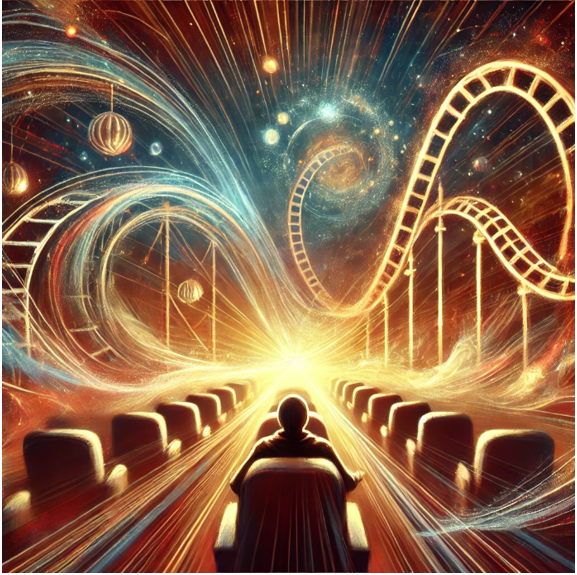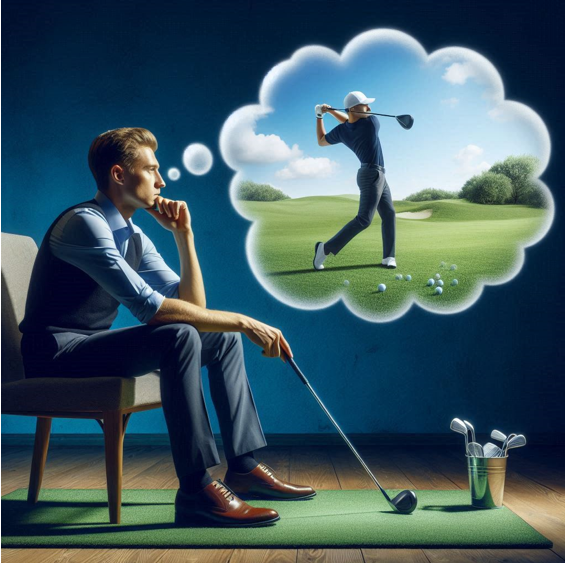The Role of Imagination
Many of the exercises that you will encounter in this course require the use of imagination. There is a very good reason for that, which has to do with our mind-body connection.
A fascinating aspect of our mind-body connection is that our subconscious mind, and our physical bodies, do not distinguish between images that are real and those that are merely imagined.
This phenomenon underscores the profound power of our thoughts and visualisations in shaping our physical and emotional states.
When we vividly imagine a scenario, our brain activates similar neural pathways as it would if we were experiencing the event in reality. Consequently, this mental imagery can elicit genuine physiological responses, such as changes in heart rate, muscle tension, and hormone levels.
We have all had the experience of being in a movie cinema where the picture on the screen is a roller coaster with the camera placed in the front seat, so that we have a first-person perspective of the roller coaster ride. I am sure it has happened to all of us that when the roller coaster moves, we feel as if we are on that roller coaster, even though we are very obviously not – we are seated at home on the couch or in a movie cinema seat. Yet our bodies still respond as if we were actually on the ride itself. We still get the same “butterflies” in our belly.

This is an example of that curious phenomenon of our mind-body connection in play. Another example is fiction itself. When we are reading a book or watching a movie, there is a part of us that knows what we are reading is not true, but there is also a part of us that reacts as if it is – we have the same physiological responses as if the event were really occurring in front of us, and this is what makes the book or movie engaging.
We see this again in the phenomenon of anxiety. Anxiety is the emotional response to the mental state called ‘worry’, where worry is the extrapolation of present circumstances into the future with consequences that are unwanted. Even though the future occurrence has not happened (i.e. it is a fantasy), we react in the present as if it were true. Anxiety is the experience in the present moment of a potential future that does not exist – it is the response to a mental image that creates an emotional/physical result in the present moment. You could say that anxiety is the dark side, or rather the mis-use, of our creative power. With anxiety we use our creative power to cut ourselves. This is also an example of that feature of the mind-body connection where the body does not distinguish between images that are real, and those that are just imagined.
This feature of our mind-body connection can be used for positive purposes as well. For instance, athletes often employ visualisation techniques to enhance their performance. By mentally rehearsing their routines, they can improve muscle memory and boost confidence, as the body begins to respond as if the physical practice is already occurring. Similarly, individuals undergoing medical treatments can visualise their bodies healing, which can activate the body’s natural healing processes and improve outcomes.

Recent studies in neuroscience have provided evidence supporting the effectiveness of these techniques. Functional MRI scans have shown that the brain’s activity during visualisation mimics the activity observed during actual physical performance. This neural mirroring indicates that mental practice can enhance physical skills and responses.
Moreover, research in psychoneuroimmunology has demonstrated that visualisation and positive thinking can boost immune function, reduce inflammation, and promote overall health. The mind-body connection is now recognised as a powerful tool in preventive medicine and holistic health practices.
These techniques are used widely in meditation as well to effect physical change.
I prefer to use the term “visu-actualisation” rather than the term “visualisation”, because with visualisation, the site of engagement is the brain – visualisation tends to be localised in the thinking head. On the other hand, the term “visu-actualisation” emphasises that the site of engagement of the technique is not just in the head, but within the body. The purpose of the exercises is not just to think about something, but to feel it in the body. The thing you imagine causes a feeling reaction inside you, which is then perceived in the physical body as actually occurring. Therefore, what you imagine becomes something real (actual) for you; this occurs through your feeling reaction to what you have imagined. This is visu-actualisation. Throughout this Course, if you see the word “visualise” or ‘visualisation”, you know that what I am actually talking about it “visu-actualise” and “visu-actualisation”. In other words, the point is not just to see/think it, but to feel the result in the body of having seen/thought it.
So, this gives rise to ways of playing with the energy body. A thought, which is an imagining, is applied to the energy body, which then responds by shaping and directing the flow of energy accordingly. This interplay allows us to harness the power of our thoughts to influence our physical and energetic states, opening up a realm of possibilities for healing, balance, and personal transformation.
This whole Course is about ways of playing with the energy body, but I want to emphasise here that the energy body is an entirely personal creative space for everyone to experiment with, and have fun with. There is no limit to the games that can be played. It’s up to you; you are the script writer, producer, and director of the show.
It’s like throwing a basketball (in this case, an imagining) to another player (your energy body), and then the other player throws the ball back – like in all games, in an entirely unpredictable manner – and you receive it, respond to what you have received, and the game continues. The point is that it could be any game you choose.
It was the genius of Taoist masters that devised exercises whereby the novice is asked to imagine features of the energy body that are actually part of energy anatomy, though the novice may not notice them at that point in their evolution. The exercises serve to “wake up” aspects of energy anatomy that lie dormant or underdeveloped.
